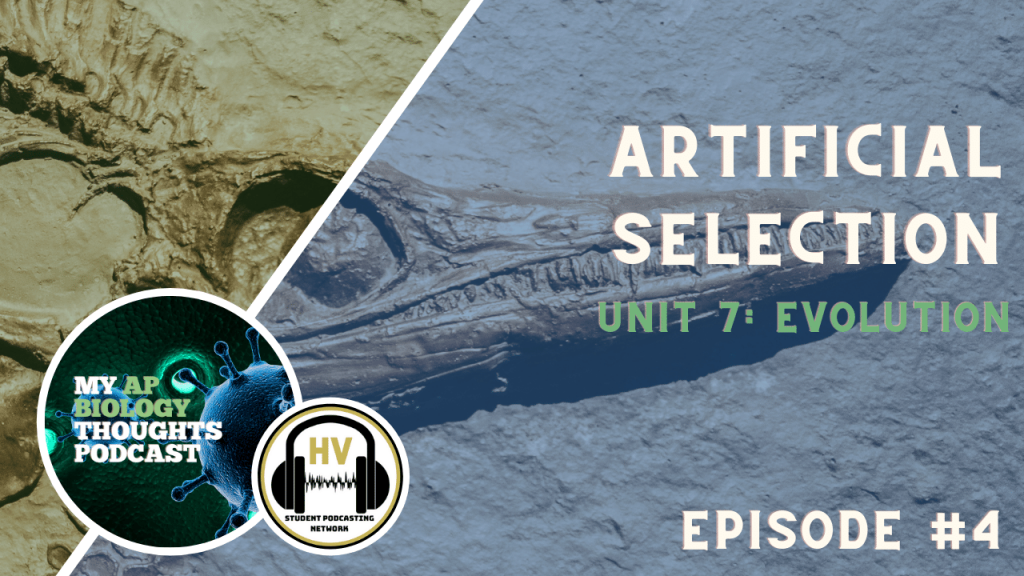Artificial Selection

My AP Biology Thoughts
Episode #4
Welcome to My AP Biology Thoughts podcast, my name is Sid and I am your host for episode #4 called Unit 7 Evolution: Artificial Selection. Today we will be discussing what artificial selection is, examples of it and how it connects to evolution.
Segment 1: Introduction to Artificial Selection
- Artificial selection is when humans use genetic variation in a population of species in order to select which traits they want passed down. Artificial selection occurs when human intervention in a species causes significant change in a gene pool.
Segment 2: Examples of Artificial Selection
- Dogs are one of the best examples of artificial selection. Today, when you’re walking down your street you may notice many different kinds of dogs. Some are large, some are small, some have brown fur, some have black fur. But why do all of these dogs look and behave so differently? This is because of artificial selection. Despite their many differences, all dogs are the same species. And as I said before, different dogs will look different, act different and have different sets of advantages and disadvantages. Humans have been using this for thousands of years in order to get these loyal companions for many different purposes. Thousands of years ago, dogs’ ancestors were just wolves. After humans tamed and bred them for thousands of years, they have become what we see today. However, humans didn’t just breed them randomly. They were selective in what traits they considered advantageous and made sure those were the traits that were to be passed down. For example, rottweilers were bred specifically to herd cattle. In order to breed a dog to do such a task, humans purposely breed two dogs with characteristics that would allow them to be efficient herding dogs. By doing this, humans select which traits they want passed down to the next generation of dogs for their own advantage. More examples of this are terriers that are good for catching rodents. In the early stages of what we see as dogs today, the wolves that have become dogs were probably those that were genetically capable of being more comfortable around humans. These wolves likely were able to eat remaining food that humans had left over allowing them to survive and reproduce which caused more wolves that were comfortable around humans. So initially, this was natural selection. After a while humans may have found use for these wolves. Some were able to get rid of pests, some were able to herd, some offered protection. They allowed those wolves to reproduce and after many years we now have dogs as we see them. Today, since a wolf and a dog would be unable to mate, we know that they are now different species entirely.
- Examples of artificial selection in different species occur as well. On farms, chickens, cattle, sheep, and pigs are the result of artificial selection and selective breeding. For cows, farmers would selectively breed cows to have cows that serve their purpose the best. They may choose cows that are best suited for meat to reproduce and create more cows that can be turned into meat for human consumption. Farmers also might breed cows that are best suited for milk production together to create more generations of cows that are best for milk production. This is done for a variety of farm animals for a variety of purposes. Still, farmers don’t use artificial selection on just animals. Artificial selection is used to create cabbage, broccoli, cauliflower, brussel sprouts, and kale. Surprisingly all of these vegetables are of the same species. Similarly, bananas are not found as we know them in the wild. In the wild, bananas are small and oval shaped and full of seeds. After humans selected the bananas which were longer and sweeter, they were able to create the sweet and easy to eat bananas we see today. This is another example of artificial selection.
Segment 3: Content Connections
- As we know, in the population of every species there is some sort of genetic variation. Because of this genetic variation, species are able to adapt and change throughout time in order to best fit their environment. This occurs in a species’ natural environment through natural selection. This however, is much different from artificial selection. Through artificial selection, humans use the genetic variation within a species and evolution occurring naturally by seeing which genes are best suited for their environment, humans choose which genes are most favorable to them. In doing this, change within a species and evolution occurs much faster. This is an example of non random mating (one of the five fingers of evolution) because in order for humans to choose which traits are passed down the mates would be specifically selected for whichever favorable traits they have. After this happens for many generations, the gene pool becomes significantly changed which means evolution has occurred.
Music Credits:
“Ice Flow” Kevin MacLeod (incompetech.com)
Licensed under Creative Commons: By Attribution 4.0 License
http://creativecommons.org/licenses/by/4.0/
Subscribe to our Podcast
- Apple Podcasts
- Spotify
- Google Podcasts
- Stitcher
- YouTube
Connect with us on Social Media
- Twitter @thehvspn

